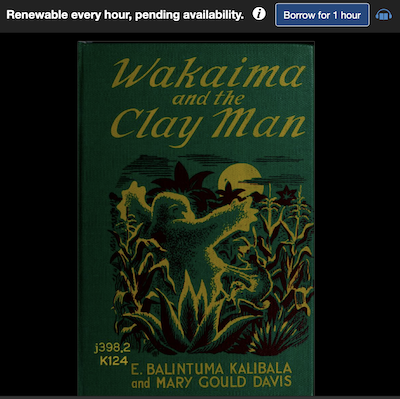The book is an old one, from 1946, and it has a striking dedication, especially for its time: "For the children of America from whose racial inheritance these stories are taken." My own interest in African folklore was prompted by reading African American folklore, but nobody ever told me about any of this when I was a child in school in the 1960s and 1970s, yet here is a book by an African author from 1946 (!) making an argument about the contribution of African storytellers to American culture, and the pride that African American children can and should take in this great storytelling inheritance. The "clay man" of the story's title is indeed an east African version of the famous "tar baby," and Wakaima is the Baganda name for Rabbit ... although I am guessing there are still many people in America who still have no idea that the Brer Rabbit stories of Uncle Remus stories owe nothing to Disney or Splash Mountain; they are, instead, African folktales.
The author's note by Balintuma Kalibala in the back of the book provides a basic introduction to Africa and the Bagandan people, along with a brief account of his life; he was born in 1902 in Kampala, Uganda, and grew up there, hearing these stories as a young boy. He also includes hints to help teachers make use of these stories in introducing American students to African storytelling traditions (something that never happened in any class I ever took in school; literally: never). He explains that he wrote down these stories at the request of teacher in St. Louis and then collaborated with Mary Gould Davis, a storyteller at the New York Public Library, in writing the actual book (more about Davis at Wikipedia).
In looking for information about Dr. Kalibala to include in this post, I discovered this letter that he wrote to W. E. B. DuBois, which you can see online here: Letter from Ernest B. Kalibala to W. E. B. Du Bois, April 26, 1925, when he was a student at the Tuskegee Institute. He went on to become an educator, rejecting colonial education meant to keep Africans in their place; see the information about him in this article: Makerere and the Beginnings of Higher Education for East Africans by Carol Sicherman, who describes him as "the kind of educated African who rattled whites." From that article, I learned that he was the first Bagandan person to get a Ph.D., which he received from Harvard in 1946, the same year he published this book of folktales.
I finally found this picture of Kalibala, thanks to a tweet (!) from Jonathon L. Earle; Dr. Kalibala is top row, second from right here at the Namirembe Conference in 1954 (larger view):
Dr. Kalibala was part of the circle of African folklorists affiliated with Franz Boas (before taking his Ph.D. at Harvard, he also studied at Columbia), and he worked with May Mandelbaum Edel in her documentation of Baganda folklife. For example, he translated Apolo Kagwa's Customs of the Baganda into English, and that book is also available at the Internet Archive:
What a fascinating character! I hope I can learn more about him in further research.
Meanwhile, back to Wakaima the Rabbit! Here is a link to each of the stories: Wakaima [Rabbit] and the Clay Man /
Wakaima and the King's Cow /
Wango [Leopard] and Wakaima /
Wakaima and His Traps /
How Mr. Elephant Got a New Hind End /
The Lamb that Talked /
The Grandmother and the Apes /
How Wambwa [Dog] Came to Be the Friend of Man /
Why Monkeys Live in Trees /
Wakikere [Frog] and Wamusota [Snake] /
Sesota, the Great Snake of Kalungu /
How Wakikere Lost His Tail /
The Question about a Cow.
The illustrations are by Avery Johnson, and they are another big plus for this book; they are really delightful:
Here's Rabbit watching all the other animals working hard... Rabbit, of course, is not:
So, I can highly recommend this book; especially in the context of its time, it really is a remarkable book by an African writer for American children; absolutely worth your time and attention!
by E. (Ernest) Balintuma Kalibala
and Mary Gould Davis






No comments:
Post a Comment
Comments are limited to Google accounts. You can also email me at laurakgibbs@gmail.com or find me at Twitter, @OnlineCrsLady.